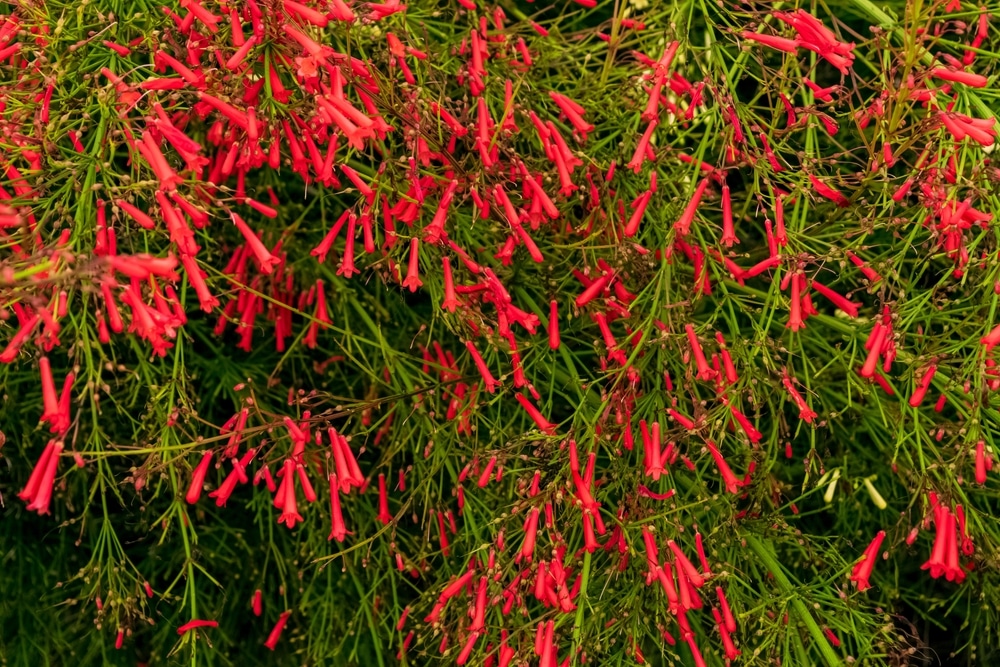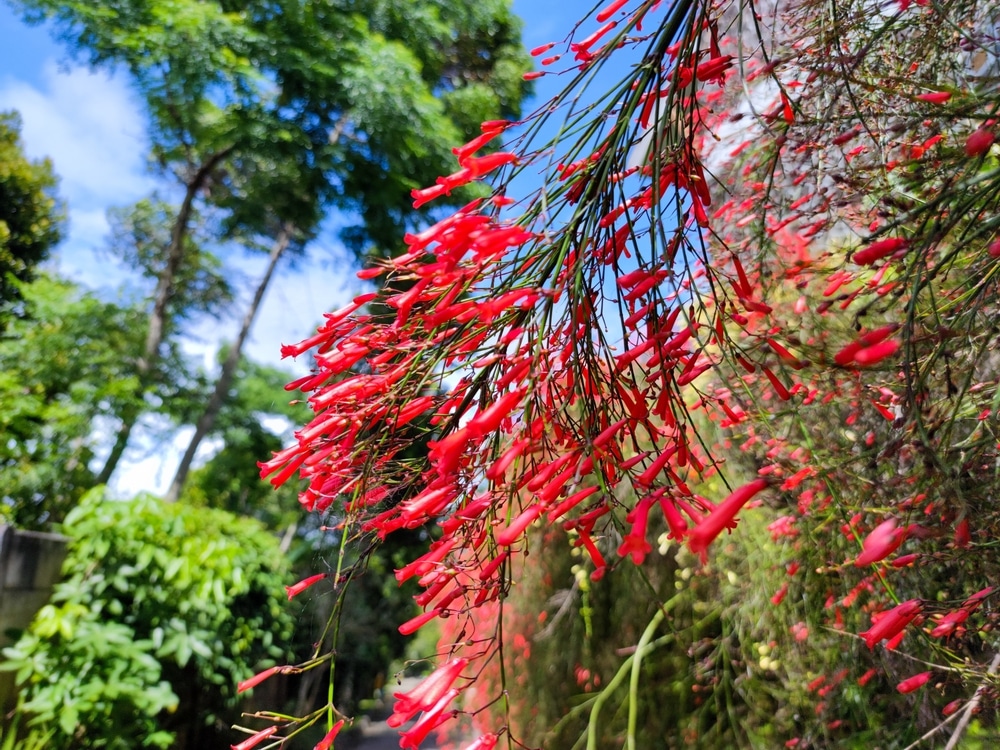The Firecracker plant is a bushy perennial that displays eye-catching blooms that grow tubular. Its flowers will attract plenty of hummingbirds and butterflies, which can make any corner of your garden more lively.
The plant is a fast grower and relatively easy to care for.
However, that doesn’t mean you don’t have to pay attention to its needs and requirements. So, if you like the idea of spicing up your yard with this plant, read this essential guide we put together for you. Here, we include everything you must know to grow a thriving Firecracker plant.
| Botanical Name | Russelia equisetiformis |
| Common Name | Firecracker Plant, fountain bush, or coral fountain |
| Plant Type | Perennial |
| Flower Color | The plant displays red to orange tubular blooms that grow in a cascading pattern. |
| Size When Mature | Up to 3 feet tall and between 3 and 5 feet wide |
| Bloom Time | From late spring to summer. |
| Sun Requirements | Full Sun |
| USDA Hardiness Zones | 9-11 |
| Soil PH Range | Between 6.0 and 7.8 |
| Soil Type | Sandy, loamy, well-draining |
| Water Needs | Medium |
| Native Area | Mexico and Guatemala |
What you Need to Know About Firecracker Plant
The firecracker plant is a fast-growing bush that needs little attention from your side to thrive. However, you must grow it in a suitable region (and offer enough space) for it to grow into the gorgeous plant you may have already seen somewhere.
Also, despite being an attractive species, the firecracker plant isn’t neat. And this means that if you prefer orderly bushes, you should look at other types of plants. Also, you’ll have to plan where to locate your firecracker plant (and consider how much it will grow).
You’ll enjoy the best of this shrub from late spring to early fall (depending on where you live). So, expect a long blooming season! However, if you have pets or children running around your garden, beware: its flowers and leaves are toxic when ingested.
How to Care for Firecracker Plant
Now that you know a little more about the plant, you might want to learn how to care for it. But don’t worry: all you have to do is jump to the following sections!
Light
These plants are native to Mexico and Guatemala, so they need plenty of sunlight to grow. After all, their natural habitats are open fields that get light from morning to night. So, we recommend you pick a sunny location for your shrub.
Of course, you can always grow it as a houseplant. However, without enough sunlight, it might display less voluminous blooming. Also, bring your plant outdoors in the spring and summer to encourage photosynthesis.
Water and Soil Needs
Firecracker plants are ideal for beginner gardeners since they aren’t too picky about their growing conditions. They will thrive in most soils, including clay and loamy. However, they will perform much better in well-draining substrates. So, consider adding sand or perlite to the mixture if you are worried about compaction.
However, don’t worry too much about the pH: these shrubs will adapt to different values.
For best results with this plant, follow a regular watering schedule, especially during the growing phase. And even if these plants can tolerate droughts, it is better not to test their resistance. After all, they will grow healthier with constant moisture as it will help them develop stronger roots.
Don’t forget to adjust your schedule to your local climate: you may have to reduce the frequency in the winter when the plant doesn’t need as many nutrients.
Temperature Requirements
These tropical plants will not perform well at low temperatures. If you are growing them outdoors, bring them inside unless you live in USDA hardiness zones between 9 and 11. Your firecracker plants won’t survive frost, so protect them from temperatures below 55°F!
Fertilizer
You won’t have to worry too much about fertilizers with firecracker plants. Indeed, in most cases, these plants will thrive without extra nutrients. Still, applying a layer of compost or manure can help encourage blooming. In essence, you will have more flowers with some nutrition!
And if you notice your plant struggling to produce flowers, consider applying liquid fertilizer. Dilute it to half the dose to minimize harm to your plant!
Common Diseases
One of the best things about growing a firecracker plant is its resistance to most diseases and pests. However, you give it what it needs to thrive to avoid issues. For instance, don’t forget to prune your plant at least once to keep it in shape and allow for adequate airflow.
Also, look for symptoms of problems and try to revert your plant to its natural conditions by providing it with all it needs to grow.
Additionally, keep an eye on bugs and take prompt measures to remove them if they appear.
Firecracker Plant Propagation
You can propagate your firecracker plant by cuttings. To do so, pick some healthy stems from your plant (they must have at least three nodes) and place them in containers with a well-draining potting mix.
Keep the pots moist without overwatering them in a location that receives plenty of indirect sunlight. In a few weeks, the plants will root. You might have to move them to a larger container in less than a month!


